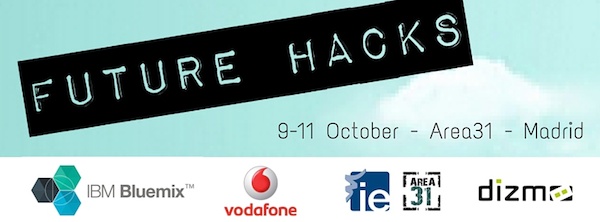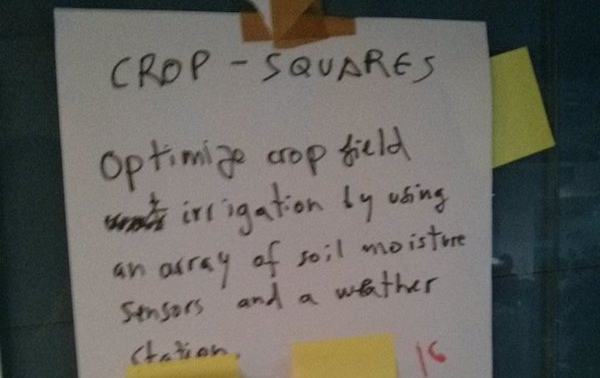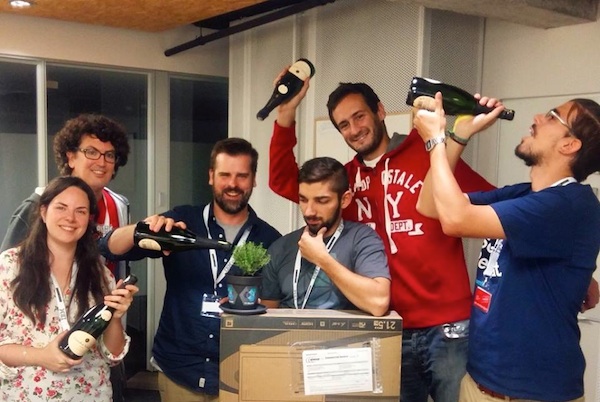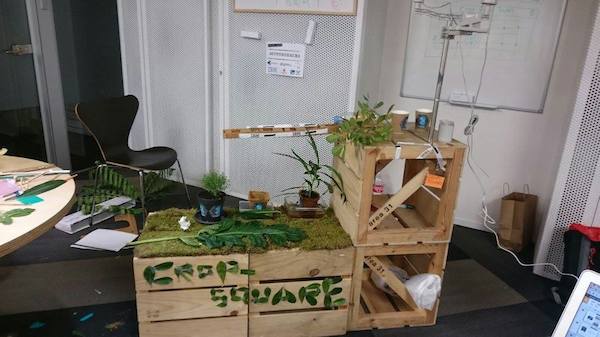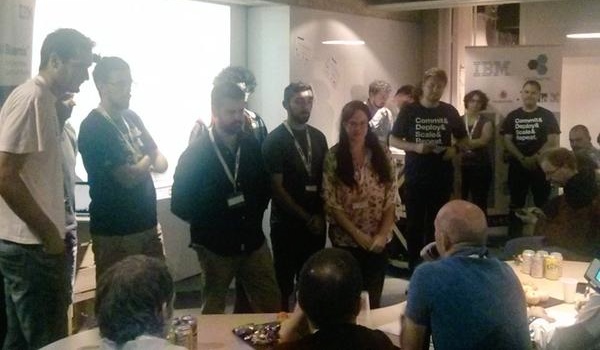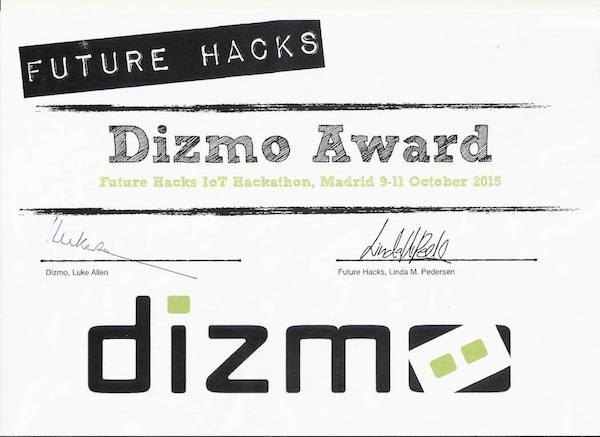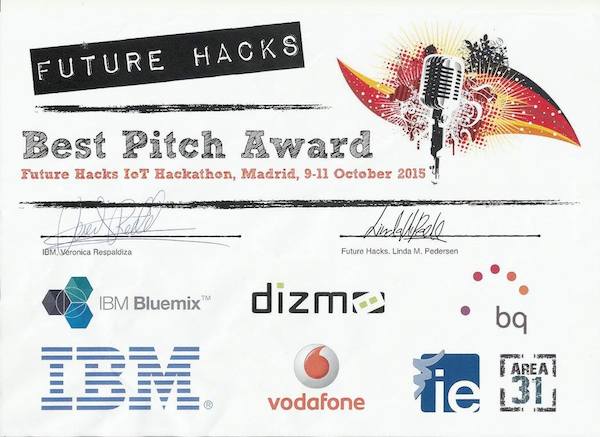# The event
This project was developed during Future Hacks Internet of Things Edition, held in Madrid, Spain between October 9th and 11th 2015.
The event was sponsored by IBM, Dizmo, Vodafone, BQ and IE Business School.
# The idea
The original idea was to "optimize crop field irrigation by using an array of soil moisture sensors and a weather station".
It aims to improve agricultural methods by continuously reading and sending sensor data to make the irrigation process sustainable and efficient, specially in developing countries or rural areas with limited resources.
The solution had to be not only cost-effective, but inexpensive, being able to 3D print parts or buid probe replacements.
The name of the project, "Crop Squares" was inspired by that concept: instead of alien circles, a square grid would provide information about the status of both the soil and the surrounding environment.
Meet the team:
- Fernando Álvarez-Uría, Software Engineer. [email protected]
- Gabriel Aldaz, Business Dev. [email protected]
- Elena Arráez, Telecom Engineer. [email protected]
- Diego Alvarado, MBA. [email protected]
- Pablo Lozano - Industrial Engineer. [email protected]
- Javier Yuste - International Management. [email protected]
We were completely strangers before the hackathon started, but thanks to the excellent attitude and brilliant creativity of each member the vibe was great, making the overall experience absolutely fantastic.
A special mention has to be made to thank our mentors, Luke Allen ([email protected]) and Markus Leutwyler ([email protected]) from Dizmo, who worked hard with us providing everything we needed to create a fantastic user interface.
For this project, we relied on the following parts:
- Raspberry Pi model B, with GPIO header break out.
- Weather Station, including both wind speed and direction sensors and a rain gauge.
- DHT22 temperature and humidity sensor.
- BMP180 temperature and pressure sensor.
- Arduino Pro Mini, Arduino Leonardo and several soil moisture sensors.
- Breadboards, jumper wires and resistors.
- Servo motor, empty bottle and cardboard for the irrigation system.
- Four wooden boxes, moss, and a Thymus vulgaris plant would complete the setup.
This list can be used as a reference for the electronic components used in our project. Notice that the Raspberry Pi has been upgraded to model 2, as model B has been discontinued.
Link to the wishlist: https://www.sparkfun.com/wish_lists/118213
DEV-11546, DEV-09873, PRT-11980, SEN-08942, SEN-10167, SEN-11824, SEN-13322, DEV-11114, DEV-11286, COM-10969, ROB-11882, KIT-12652, PRT-12046, WRL-13678, PRT-09567, PRT-12796, PRT-12794, PRT-12795.
For the Raspberry Pi, we used Raspbian operating system.
We compiled Node.js runtime and installed Node-RED workflow tool, to deliver sensor data through IBM Bluemix IoTF MQTT Broker.
However, some technical difficulties prevented Node-RED to stablish a stable connection to Bluemix, and we had to failover to Mosquitto MQTT test server.
We wrote some Python scripts based on Adafruid Industries libraries that read data from the weather station sensors and broadcast them through MQTT.
For the soil probes, we connected a moisture sensor to an Arduino Pro Mini, and then sent all data through an ESP8266 WiFi module.
To make things easier, we flashed the ESP8266 module with NodeMCU firmware, providing an environment that allowed us to develop WiFi related routines using Lua programming language.
An Arduino Leonardo read another moisture probe, activating a servo motor that pushed up a water bottle to perform the irrigation process:
The Crop Squares grafical user interface was implemented using a touch screen interface running Dizmo software to show the measurements collected by the sensors. The first thing displayed in this interface is a map of the crop field.
Rectangles asigned to each soil sensor change their color depending on moisture levels (green, yellow and red).
They could also be selected to display the weather station results for that area in real time. During the demo version we show real time data from our weather station with its sensors connected to the Raspberri Pi.
We performed variations in soil moisture level by watering some plants, so the color of the first area was updated in real time too.
IBM Watson would eventually help us to interact with the information and make decisions through the Dialog and Question and Answer services, with voice input/output through Speech-to-Text and Text-to-Speech.
Visual Recognition would allow Bluemix to recognize the different users and also identify posible threats to crops through the cameras located around the crops.
The readings from the sensors were delivered to Bluemix through the IoT Foundation.
Bluemix then would both store and receive data from related sources as the Spanish Weather Service or farming databases.
This would allow IBM Watson Analytics to determine the optimal moment to irrigate, the ideal quantities of water to use and any additional risks to the crops such as excessive temperature, heavy winds or over watering.
An eventual farmer would be helped by this data in his decision making.
For the assembly of the prototype, we used four wooden boxes available at IE's Area 31 assembled like a rotated Tetris L-Block.
We mounted the weather station on top of two stacked boxes, connecting the Rapsi, breadboards, Arduinos and servos inside the lower one.
A couple of empty plastic bottles were placed under the rain gauge to collect water.
An impromptu rain gutter deliverd water from a plastic bottle actuated by a servo, watering three plants placed on the lower two boxed.
Thos plants had moisture sensors that both activated the servo and sent data to the MQTT broker to be suscribed by the Dizmo app.
As a gimmick, we outputted a rain and thunderstorm recording though Raspi's audio jack when the rain gauge activated, to add some special effects during the presentation.
The jury was formed by Jorge Arévalo, Software Developer from Reclamador, Enrique Martín, Innovarion Director for Business from Vodafone, Álvaro Everlet, CTO from Carriots and Elisa Martín Garijo, Director of Technology and Innovation from IBM Spain, Portugal, Greece and Israel.
We experienced some technical difficulties that prevented us from showing the Dizmo UI, sorting it out by using our slides and the actual display of the rig.
We were asked questions regarding possible uses and market differentiation before finishing out our pitch.
We won two out of five possible awards, receiving an Acer touch screen, a perpetual Dizmo license for each team member and six bottles of champagne.
Overall, the experience was trully rewarding, and we hope to have the chance to participate in the next edition of Future Hacks.
October 13th, 2015
October 15th, 2015
### Article: Making IoT tech “farmer-friendly” with dizmo
November 17th, 2015
### Article: Optimizing Crop Yield With IoT
